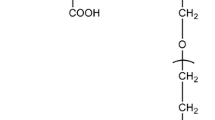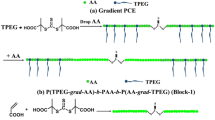Abstract
Ester-based polycarboxylate superplasticizer was produced by esterification product of polyethylene glycol and acrylic acid. Variation law of polyethylene glycol di-acrylate content accompanying with esterification ratio and side effect to performance of polycarboxylate superplasticizer was studied by reversed-phase high performance liquid chromatography. Experimental results showed that both polyethylene glycol mono-acrylate and polyethylene glycol di-acrylate existed in the esterification product. Ratio of di- and mono-acrylate contents sharply rose when esterification ratio increased. When esterification ratio was 26 %, there was a certain amount of di-acrylate. When esterification ratio of the system was 85 %, the content of di-acrylate was 18.5 %, ratio of di-ester and mono-ester contents was 0.38, while the highest fluidity of cement paste with the addition of polyacrylate superplasticizer was obtained as 275 mm. And when esterification ratio was more than 109 %, di-acrylate content increased more rapidly, while increment of mono-acrylate content slowed down and even began to decrease. Increment of di-acrylate content caused not only cross-linking of polycarboxylate superplasticizer but also its gelation, which affected the performance of polyacrylate superplasticizer. Based on these works, purified mono-acrylate was used to produce polyacrylate superplasticizer, by which fluidity of cement paste were all above 300 mm and obviously better than the polyacrylate superplasticizer synthesized by unpurified esterification product.






Similar content being viewed by others
Abbreviations
- Pas:
-
Polyacrylate superplasticizer
- PCs:
-
Polycarboxylate superplasticizer
- PEG:
-
Polyethylene glycol
- AA:
-
Acrylic acid
- PEGmA:
-
Polyethylene mono-acrylate
- PEGdA:
-
Polyethylene glycol di-acrylate
- RP-HPLC:
-
Reversed phased high performance liquid chromatography
- FCP:
-
Fluidity of cement paste
- GPC:
-
Gel permeation chromatography
- M w :
-
Weight average molecular weight
- M n :
-
Number average molecular weight
- MWD:
-
Molecular weight distribution
- v/v:
-
Volume ratio
- n/n:
-
Molar ratio
- ω:
-
Mass percentage
References
Sakai E, Yamada K, Ohta A (2003) Molecular structure and dispersion-adsorption mechanisms of comb-type superplasticizer used in Japan. J Adv Concr Technol 1:16–25
Li C-Z, Feng N-Q, Li Y-D, Chen R-J (2005) Effects of polyethylene oxide chains on the performance of polycarboxylate type water-reducers. Cement Concr Res 35:867–873
Kinoshita M, Nawa T, Lida M, Ichiboji H (2000) Effect of chemical structure on fluidizing mechanism of concrete superplasticizer containing polyethylene oxide graft chains. In: 6th CANMET/ACI Int Confe Superplast Other Chem Admix Conc, Am Concr Inst, Nice, France pp 163–180
Yamada K, Takahashi T, Hanehara S, Matsuhisa M (2000) Effects of the chemical structure on the properties of polycarboxylate-type superplasticizer. Cement Concr Res 30:197–207
Nawa T, Ichibouji H, Shoji D, Uchiyama J (1999) The effect of chemical structure of superplasticizers on the fluidity of cement pastes and the hydration of cement. JCA Proc Cement Conc 53:751–758 (Japanese)
Zhang RG, Guo HL, Lei JH, Zhang AF, Gu HJ (2007) Effect of molecular structure on the performance of polyacrylic acid superplasticizer. J Wuhan Univ Technol 22:245–249
Zhang RG, Li Q, Zhang AF, Liu Y, Lei JH (2008) The synthesis technique of polyacrylic acid superplasticizer. J Wuhan Univ Technol 23:830–833
Wu H, Guo HL, Lei JH, Zhang RG, Liu Y (2007) Research on synthesis and action mechanism of polycarboxylate superplasticizer. Front Chem China 2:322–325
Plank J, Pöllmann K, Zouaoui N, Andres PR, Schaefer C (2008) Synthesis and performance of methacrylic ester based polycarboxylate superplasticizers possessing hydroxy terminated poly (ethylene glycol) side chains. Cement Concr Res 38:1210–1216
Stockburger GJ, Brandner JD (1966) The reaction of ethylene oxide with oleic acid. J Am Oil Chem Soc 43:6–10
Liu M, Xie C, Xu W, Lu WY (2004) Separation of polyethylene glycols and their amino-substituted derivatives by high-performance gel filtration chromatography at low ionic strength with refractive index detection. J Chromatogr A 1046:121–126
Berthod A, Tomer S, Doesey JG (2001) Polyoxyethylene alkyl ether nonionic surfactants: physicochemical properties and use for cholesterol determination in food. Talanta 55:69–83
Potemkin II, Palyulin VV (2009) Comblike macromolecules. Polym Sci Ser A 51:123–149
Witte RP, Blake AJ, Palmer C, Kao WJ (2004) Analysis of poly(ethylene glycol)-diacrylate macromer polymerization within a multicomponent semi-interpenetrating polymer network system. J Biomed Mater Res A 71:508–518
Zhang A-F, Du X-D, Lei J-H, Liu Y, Bi Y (2010) Determination of polyethylene glycol monoester acrylate and polyethylene glycol diester acrylate using reversed-phase high-performance liquid chromatography. Anal Lett 43:858–866
Lei J-H, Li H, Zhang A-F, Du X-D, Lu Q (2012) Separation of monoester and diester in the esterification product of polyethylene glycol and acrylic acid by the weibull method. J Surfact Deterg 15:117–121
Berth G, Lexow D (1991) The determination of the molecular weight distribution of pectins by calibrated GPC. Part II: the universal calibration. Carbohydr Polym 15:51–65
Zinck P, Terrier M, Mortreux A, Vissaux M (2009) On the number-average molecular weight of poly (1,4-trans isoprene) determined by conventional GPC. Polym Test 28:106–108
Acknowledgments
The authors gratefully acknowledge the Western Region Traffic Construction Technology Program of the Ministry of Communications of China (No. 2007319811130).
Author information
Authors and Affiliations
Corresponding author
Rights and permissions
About this article
Cite this article
Lei, JH., Li, H., Du, XD. et al. Effect of diester in esterification product of polyethylene glycol and acrylic acid on the performance of polycarboxylate superplasticizer. Iran Polym J 22, 117–122 (2013). https://doi.org/10.1007/s13726-012-0110-6
Received:
Accepted:
Published:
Issue Date:
DOI: https://doi.org/10.1007/s13726-012-0110-6




